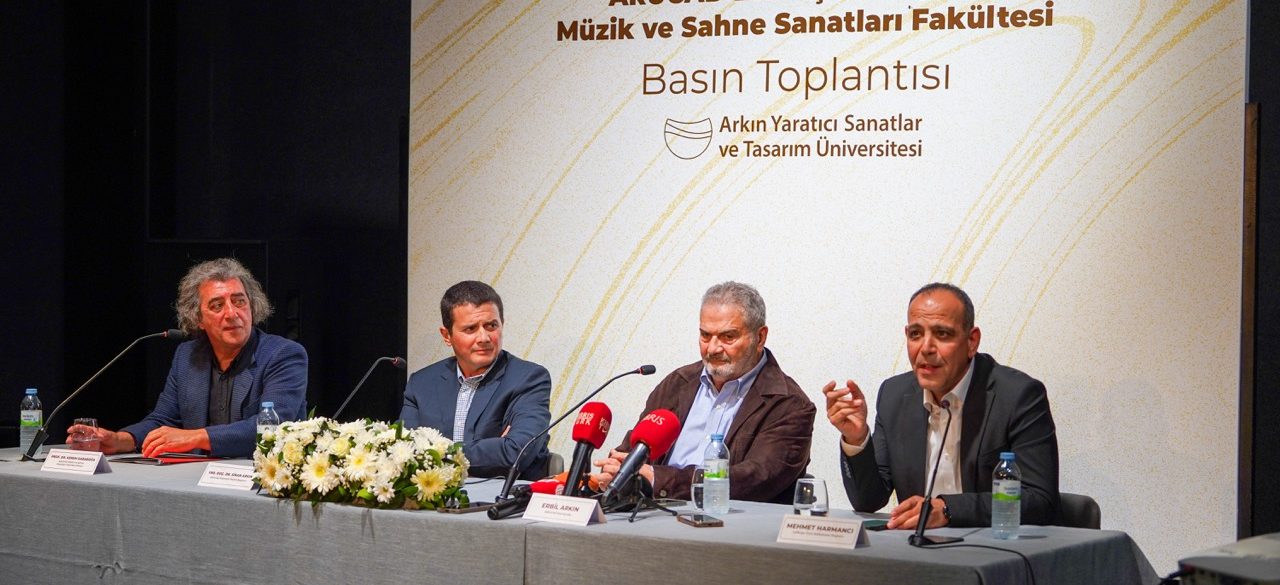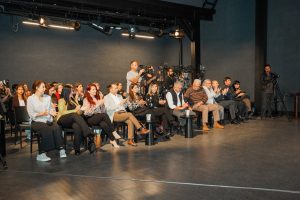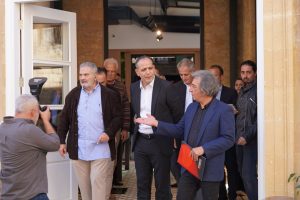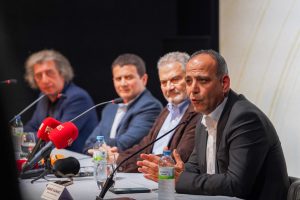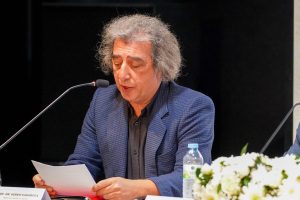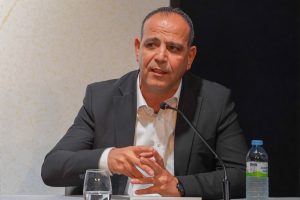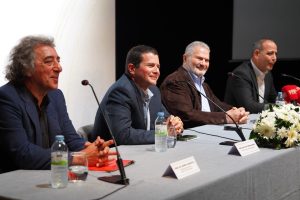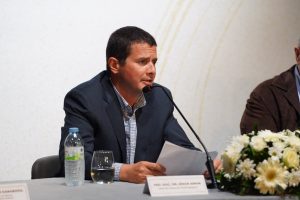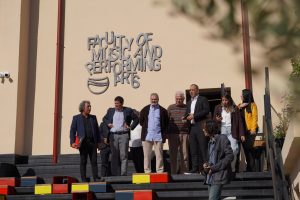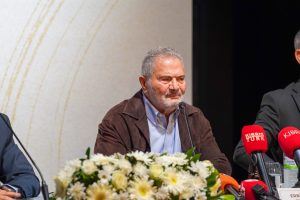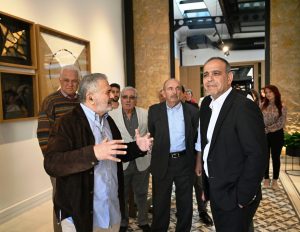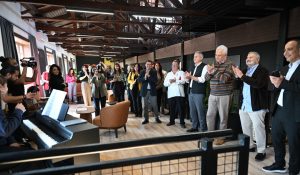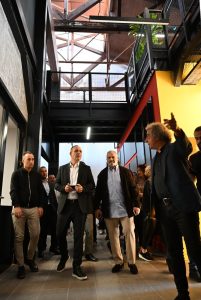Arkin University of Creative Arts and Design (ARUCAD) has officially opened the new campus of its Faculty of Music and Performing Arts, located in the heart of Nicosia Walled City, within the historic Bandabuliya complex. Home to the Acting, Contemporary Dance and Sound Arts Design Departments, the Faculty enhances students’ learning experiences through newly restored studios, performance spaces, laboratories and workshops, while bringing renewed dynamism to the cultural and artistic life of Nicosia.
The press conference, held on Wednesday, 19 November at the Bandabuliya Stage, was attended by Mayor of Nicosia Turkish Municipality Mehmet Harmancı, ARUCAD Founder Erbil Arkın, ARUCAD Chair of the Board of Trustees Asst. Prof. Dr. Sinan Arkın, and Dean of the Faculty of Music and Performing Arts Prof. Dr. Kerem Karaboğa. ARUCAD Rector Prof. Dr. Asım Vehbi, who is currently in Azerbaijan for important institutional meetings, could not attend the event but conveyed his greetings and expressed his best wishes for the new campus.
Erbil Arkın: “These efforts reflect a vision that will live not for 15 or 50, but for 100 years”
ARUCAD Founder Erbil Arkın stated that the projects initiated in the region are not shaped by short-term expectations, but by a vision intended to last for generations. Emphasizing that the restoration and transformation efforts aim to create urban values that will continue to live 15, 20, 50 and even 100 years into the future, Arkın said: “We want our great-grandchildren to benefit from these spaces. We are working to build a beautiful Nicosia that we can all be proud of.”
Arkın underlined that restoration is an essential tool for beautifying the city and revitalizing its collective memory. He expressed his gratitude to the Nicosia Turkish Municipality for its previous contributions to the area and emphasized ARUCAD’s determination to continue these efforts without interruption. He concluded his remarks by saying, “We will not stop; we will go further.”
Mehmet Harmancı: “ARUCAD has accomplished a remarkable transformation story”
Mayor of Nicosia Turkish Municipality Mehmet Harmancı highlighted the importance of Bandabuliya in the city’s social memory. Noting that construction began in 1929 and the building was opened to the public in 1932, Harmancı explained that Bandabuliya served as one of Nicosia’s primary gathering points for many years. With increasing needs in the 1940s, the Wholesale Market (Toptancılar Hali) was constructed to strengthen the economic structure of the region.
Harmancı emphasized that all transformation projects in the Walled City are carried out with respect for historical heritage, social harmony and economic vibrancy. He noted that the Bandabuliya Stage and Toptancılar Hali were renewed accordingly. He explained that the building was transferred to ARUCAD through a transparent public tender launched by the Nicosia Turkish Municipality in June 2021, adding that although the Municipality invited many potential candidates, only Erbil Arkın believed in the vision and took responsibility.
“ARUCAD has accomplished a remarkable transformation story,” Harmancı said. “We did not choose ARUCAD. We envisioned that powerful institutions or universities could revive this building — but only ARUCAD believed in this dream. Only Mr. Erbil Arkın stepped forward. They submitted the sole bid, and together we started an important journey. One of our key goals for the Walled City was bringing education into the area. With education and young people, Suriçi has regained its dynamism. We have successfully implemented the vision our country has outlined — and I am very proud of that.”
Harmancı added that the project proceeded with the approval of the High Council of Antiquities, that a new public space was created behind the building, and that the entire process has generated new cultural and educational vitality in the Walled City.
Asst. Prof. Dr. Sinan Arkın: “This transformation is the product of trust, patience and collective effort”
ARUCAD Chair of the Board of Trustees Asst. Prof. Dr. Sinan Arkın noted that reaching the current state of Bandabuliya was not easy. The restoration process was prolonged due to the pandemic, supply shortages and various technical challenges. Despite these difficulties, the project advanced with strong belief and determination.
“What gives value to a building is not its walls, but the people who create inside them,” Arkın said, underlining the significance of the Bandabuliya Campus as a cultural hub. He emphasized that the transformation contributes to the revival of creative production in the Walled City and brings long-term value to the city.
Prof. Dr. Kerem Karaboğa: “This building will be a center for creative research and interdisciplinary production”
Dean of the Faculty of Music and Performing Arts Prof. Dr. Kerem Karaboğa stated that the Bandabuliya Campus is designed not only as an educational facility but as a center for creative research and interdisciplinary artistic production. Emphasizing that the Acting, Contemporary Dance and Sound Arts Design Departments will shape a strong creative ecosystem within the space, Karaboğa noted that the Black Box theatre, contemporary dance studios, multi-purpose rehearsal rooms and sound design laboratories offer students both theoretical and practice-based learning opportunities. He added that the Bandabuliya Campus is designed as a venue open to collaborations with local and international artistic communities, enriching the cultural life of the city.
A living ecosystem of culture and education in the Walled City
The ARUCAD Lefkoşa Campus has been designed to serve both students and the city’s cultural life, offering a performance-ready Black Box theatre, contemporary dance studios, sound design laboratories, multi-purpose rehearsal rooms and creative production environments. The campus is expected to become a major focal point that strengthens public life in the Walled City.
A space that preserves the past while adding value to the future
Preserving its historic identity while gaining new function, Bandabuliya now stands as a center that carries Nicosia’s urban memory into the future through education and cultural production. The program concluded with a guided tour of the facilities followed by a reception.



